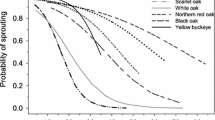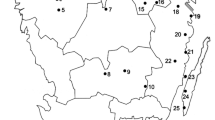Abstract
Sustainable harvest of natural products that meets the needs of local people has been viewed by many as an important means for sustaining conservation projects. Although plants often respond to tissue damage through compensatory growth, it may not secure long-term sustainability of the populations because many plants enhance individual well-being at the expense of propagation. Sustainability may further be threatened by infrequent, large-scale events, especially ill-documented ones. We studied the impacts of sprout harvesting on sprout growth in a dwarf bamboo (Pseudosasa usawai) population that has seemingly recovered from an infrequent, large-scale masting event. Experimental results suggest that although a single sprout harvest did not significantly alter the subsequent abundance and structure of sprouts, culm damage that accompanied sprout harvesting resulted in shorter, thinner, and fewer sprouts. Weaker recovery was found in windward, continually harvested, and more severely damaged sites. These findings suggest that sprout growth of damaged dwarf bamboos is likely non-compensatory, but is instead supported through physiological integration whose strength is determined by the well-being of the supplying ramets. Healthy culms closer to the damage also provided more resources than those farther away. Sustainable harvesting of sprouts could benefit from organized community efforts to limit the magnitude of culm damage, provide adequate spacing between harvested sites, and ensure sufficient time interval between harvests. Vegetation boundaries relatively resilient to infrequent, large-scale events are likely maintained by climatic factors and may be sensitive to climate change. Continual monitoring is, therefore, integral to the sustainability of harvesting projects.




Similar content being viewed by others
References
Abe M, Miguchi H, Nakashizuka T (2001) An interactive effect of simultaneous death of dwarf bamboo, canopy gap, and predatory rodents on beech regeneration. Oecologia 127:281–286
Allen CD, Breshears DD (1998) Drought-induced shift of a forest–woodland ecotone: rapid landscape response to climate variation. Proc Natl Acad Sci 95(25):14839–14842
Anderson MT, Frank DA (2003) Defoliation effects on reproductive biomass—importance of scale and timing. J Range Manag 56(5):501–516
Anten NPR, Martínez-Ramos M, Ackerly DD (2003) Defoliation and growth in an understory palm—quantifying the contributions of compensatory responses. Ecology 84(11):2905–2918
Chen WK, Tsai CY (1983) The climate of Yangmingshan National Park. Yangmingshan National Park, Construction and Planning Agency Ministry of the Interior, Executive Yuan, Taipei
Crow TR, Perera AH (2004) Emulating natural landscape disturbance in forest management—an introduction. Landsc Ecol 19(3):231–233
Endress BA, Gorchov DL, Noble RB (2004) Non-timber forest product extraction: effeccts of harvest and browsing on an understory palm. Ecol Appl 14(4):1139–1153
Endress BA, Gorchov DL, Berry EJ (2006) Sustainability of a non-timber forest product: effects of alternative leaf harvest practices over 6 years on yield and demography of the palm Chamaedorea radicalis. For Ecol Manag 234(1–3):181–191
Ennos AR (1997) Wind as an ecological factor. Trends Ecol Evol 12:108–111
Fries C, Johansson O, Pettersson B, Simonsson P (1997) Silvicultural models to maintain and restore natural stand structures in Swedish boreal forests. For Ecol Manag 94(1–3):89–103
Gagnon PR, Platt WJ, Moser EB (2007) Response of a native bamboo [Arundinaria gigantea (Walt.) Muhl] in a wind-disturbed forest. For Ecol Manag 241:288–294
Gaoue OG, Ticktin T (2010) Effects of harvest of nontimber forest products and ecological differences between sites on the demography of African Mahogany. Conserv Biol 24(2):605–614
Ghimire KB, Pimbert MP (1997) Social change and conservation. Earthscan, London
Hayata B (1916) General index to the flora of Formosa. (Supplement to Icones Plantarum Formosanarum), vol 6. Civil Government Formosa Press, Taihoku, pp 136–138
Hsu KS, LIn ZT, Chen CF, Kao JY (1986) The Ecological studies of usawa dwarf-bamboo in Yanmingshan National Park. Yangmingshan National Park, Construction and Planning Agency Ministry of the Interior, Executive Yuan, Taipei
Huang TC (ed) (2000) Flora of Taiwan, 2nd edn. Editorial Committee of the Flora of Taiwan, Department of Botany, National Taiwan University, Taipei
Huang S (2002) The regeneration and reproduction biology of Pseudosasa usawai in Yangmingshan National Park. Yangmingshan National Park, Construction and Planning Agency Ministry of the Interior, Executive Yuan, Taipei, Taiwan
Huang S, Lin SM (2007) The dynamic at the boundary between Miscanthus and dwarf-bamboo grassland. Yangmingshan National Park, Construction and Planning Agency Ministry of the Interior, Executive Yuan, Taipei, Taiwan
Huang S, Liao PJ, Huang BH (2004) The ecology, habitat and natural regeneration of dwarf-bamboo in Yangmingshan National Park. Yangmingshan National Park, Construction and Planning Agency Ministry of the Interior, Executive Yuan, Taipei, Taiwan
Huhta A-P, Hellström K, Rautio P, Tuomi J (2003) Grazing tolerance of Gentianella amarella and other monocarpic herbs: why is tolerance highest at low damage levels? Plant Ecol 166(1):49–61
Janzen DH (1976) Why bamboos wait so long to flower. Annu Rev Ecol Syst 7:347–391
Kitamura K, Kawahara T (2009) Clonal identification by microsatellite loci in sporadic flowering of a dwarf bamboo species, Sasa cernua. J Plant Res 122(3):299–304
Konno Y (2001) Feedback regulation of constant leaf standing crop in Sasa tsuboiana grasslands. Ecol Res 16(3):459–469
Kuipers SE (1997) Trade in medicinal plants. In: Bodeker G, Bhat KKS, Burley J, Vantomme P (eds) Medicinal plants for forest conservation and health care. Food and Agriculture Organization, Rome, pp 45–59
Landres PB, Morgan P, Swanson FJ (1999) Overview of the use of natural variability concepts in managing ecological systems. Ecol Appl 9:1179–1188
Li R, Werger MJ, Hd Kroon, During HJ, Zhong ZC (2000) Interaction between shoot age structure, nutrient availability and physiological intergration in the Giant Bamboo Phyllostachys pubescens. Plant Biol 2:437–446
Lin WC (1976) The classification of subfamily Bambusoideae in Taiwan (continued). In: Taiwan Forestry Research Institute Bulletin, vol 271. Taiwan Forestry Research Institute, Taipei
MacDonald GM, Edwards TWD, Moser KA, Pienitz R, Smol JP (1993) Rapid response of treeline vegetation and lakes to past climate warming. Nature 361:243–246
Makita A, Konno Y, Fujita N, Ki Takada, Hamabata E (1993) Recovery of a Sasa tsuboiana population after mass flowering and death. Ecol Res 8(2):215–224
Marshall C (1990) Source-sink relations of interconnected ramets. In: van Groenendael JdK H (ed) Clonal growth in plants: regulation and function. SPB Academic Publishing, The Hague, pp 23–41
Martínez-Ramos M, Anten NPR, Ackerly DD (2009) Defoliation and ENSO effects on vital rates of an understorey tropical rain forest palm. J Ecol 97(5):1050–1061
Mattheck C (1991) Trees: the mechanical design. Springer, Heidelberg
McRae DJ, Duchesne LC, Freedman B, Lynham TJ, Woodley S (2001) Comparisons between wildfire and forest harvesting and their implications in forest management. Environ Rev 9(4):223–260
Meyer GA (1998) Mechanisms promoting recovery from defoliation in goldenrod (Solidago altissima). Can J Bot 76:450–459
Nakashizuka T (1988) Regeneration of beech (Fagus crenata) after the simultaneous death of undergrowing dwarf bamboo (Sasa kurilensis). Ecol Res 3:21–35
Nakashizuka T, Numata M (1982) Regeneration process of climax beech forests I. structure of a beech forest with the undergrowth of Sasa. Jap J Ecol 32:57–67
Palik BJ, Mitchell RJ, Hiers JK (2002) Modeling silviculture after natural disturbance to sustain biodiversity in the longleaf pine (Pinus palustris) ecosystem: balancing complexity and implementation. For Ecol Manag 155(1–3):347–356
Quine C, Humphrey J, Ferris R (1999) Should the wind disturbance patterns observed in natural forests be mimicked in planted forests in the British uplands? Forestry 72(4):337–358
Quitete Portela RC, Bruna EM, Maës dos Santos FA (2010) Demography of palm species in Brazil’s Atlantic forest: a comparison of harvested and unharvested species using matrix models. Biodivers Conserv 19(8):2389–2403
Saitoh T, Seiwa K, Nishiwaki A (2002) Importance of physiological integration of dwarf bamboo to persistence in forest understorey: a field experiment. J Ecol 90:78–85
Schwartz MW, Caro TM, Banda-Sakala T (2002) Assessing the sustainability of harvest of Pterocarpus angolensis in Rukwa Region, Tanzania. For Ecol Manag 170(1–3):259–269
Seymour RS, White AS, deMaynadier PG (2002) Natural disturbance regimes in northeastern North America—evaluating silvicultural systems using natural scales and frequencies. For Ecol Manag 155(1–3):357–367
Staalduinen M, Anten NR (2005) Differences in the compensatory growth of two co-occurring grass species in relation to water availability. Oecologia 146(2):190–199
Stowe KA, Marquis RJ, Hochwender CG, Simms EL (2000) The evolutionary ecology of tolerance to consumer damage. Annu Rev Ecol Syst 31(1):565–595
Su HJ (1984) Studies on the climate and vegetation types of the natural forests in Taiwan (II) Altitudinal vegetation zones in relation to temperature gradient. Q J Chin For 17:57–73
Taylor AH, Qin Z (1988) Regeneration of Sinarundinaria fangiana, a bamboo, from seed in the Wolong giant panda reserve Sichuan China. Am J Bot 75:1065–1073
Taylor AH, Huang J, Zhou S (2004) Canopy tree development and undergrowth bamboo dynamics in old-growth Abies-Betula forests in southwestern China: a 12-year study. For Ecol Manag 200:347–360
Telewski FW (1995) Wind-induced physiological and developmental responses in trees. In: Coutts MP, Grace J (eds) Wind and trees. Cambridge University Press, Cambridge
Thomson V, Cunningham S, Ball M, Nicotra A (2003) Compensation for herbivory by Cucumis sativus through increased photosynthetic capacity and efficiency. Oecologia 134(2):167–175
Ticktin T (2004) The ecological implications of harvesting non-timber forest products. J Appl Ecol 41(1):11–21
Ticktin T, Nantel P, Ramirez F, Johns T (2002) Effects of variation on harvest limits for nontimber forest species in Mexico. Conserv Biol 16(3):691–705
Tukey JW (1951) Reminder sheets for “Discussion of paper on multiple comparisons by Henry Scheffé.”. The collected works of John W. Tukey VIII. Multiple comparisons: 1948–1983. Chapman and Hall, New York, pp 469–475
Turner MG, Collins SL, Lugo AE, Magnuson JJ, Rupp TS, Swanson FJ (2003) Disturbance dynamics and ecological response: the contribution of long-term ecological research. Bioscience 53:46–56
Wada N (1993) Dwarf bamboo affect the regeneration of zoochorous trees by providing habitats to acorn-feeding rodents. Oecologia 94:403–407
Wells M, Brandon K, Hannah L (1992) People and parks: linking protected area management with local communities. The World Bank, Washington, DC
Whitehead FH (1963) Experimental studies of the effect of wind on plant growth and anatomy. New Phytol 62(1):80–85
Zuidema PA, De Kroon H, Werger MJ (2007) Testing sustainability by prospective and retrospective demographic analyses: evaluation for palm leaf harvest. Ecol Appl 17(1):118–128
Acknowledgments
The authors thank Miss Pei-Yu Wu and many students of the Department of Life Science, Chinese Culture University, Taiwan for their help in data collection. We thank Drs. Shong Huang, Hen-Biao Kim, and Ching-Ming Lu for valuable comments on an earlier manuscript, and three anonymous reviewers and the editors for valuable comments on the manuscript. Funding for this research was provided by the Yangmingshan National Park, Taiwan.
Author information
Authors and Affiliations
Corresponding author
Rights and permissions
About this article
Cite this article
Liao, CC., Chang, CR., Hsu, MT. et al. Experimental Evaluation of the Sustainability of Dwarf Bamboo (Pseudosasa usawai) Sprout-Harvesting Practices in Yangminshan National Park, Taiwan. Environmental Management 54, 320–330 (2014). https://doi.org/10.1007/s00267-014-0296-9
Received:
Accepted:
Published:
Issue Date:
DOI: https://doi.org/10.1007/s00267-014-0296-9




